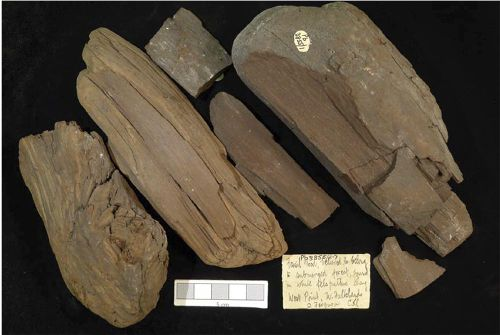OR/14/040 West Point Forest Bed
| Stone, P. 2014. Recent contributions on Falkland Islands bedrock geology, with an inventory of representative lithostratigraphical specimens held by the British Geological Survey. British Geological Survey Internal Report, OR/14/040. |
The origin of the West Point Forest Bed has been much debated. It is a clay layer packed with tree debris and found beneath solifluction deposits close to sea level on West Point Island, West Falkland (Figure 1). Halle (1911)[1] had thought it to be the remains of an in situ, pre-glacial tree cover, whereas Baker (1924)[2] concluded that it was simply a buried accumulation of driftwood. Subsequent investigations of the contained palynomorph assemblage, reviewed by Aldiss and Edwards (1999)[3], favoured Halle but suggested a Tertiary age considerably older than he had anticipated, perhaps as far back as the Early Oligocene. More recently, a very detailed study by Macphail and Cantrill (2006)[4] has supported the Tertiary interpretation, but indicated more specifically a slightly younger, Middle Miocene to Early Pliocene age. This was based on the time distribution of a number of rare pollen types and the present-day ecology of their nearest living relatives in South America and the Pacific region. The bed derives from a wet, temperate rainforest in which a variety of tall gymnosperms formed an overstorey above a closed canopy dominated by Nothofagus spp. An extinct, probably shrub-sized conifer appears to have formed the ground cover. It is highly likely that at the time of its growth this forest community covered much of the Falkland Islands.
Specimens of the West Point Forest Bed that had been collected in 1913 during a mineral prospecting exercise by David Ferguson (carried out on behalf of the Salvesen Whaling Company, then active in the Falklands) have recently been relocated in the Hunterian Museum, University of Glasgow (Stone and Faithfull 2013a)[5]. They are the best examples of the preserved wood known to exist in any museum collection (Figure 5).

References
- ↑ HALLE, T G. 1911. On the geological structure and history of the Falkland Islands. Bulletin of the Geological Institution of the University of Uppsala, Vol. 11, 115–229.
- ↑ BAKER, H A. 1924. Final Report on Geological Investigations in the Falkland Islands, 1920–1922. Government Printer, Stanley. 38pp, map, cross-section and 18 figures.
- ↑ ALDISS, D T, and EDWARDS, E J. 1999. The Geology of the Falkland Islands. British Geological Survey Technical Report, WC/99/10. 135pp.
- ↑ MACPHAIL, M, and CANTRILL, D J. 2006. Age and implications of the Forest Bed, Falkland Islands, southwest Atlantic Ocean: Evidence from fossil pollen and spores. Palaeogeography, Plaeoclimatology, Palaeoecology, Vol. 240, 602–629.
- ↑ STONE, P, and FAITHFULL, J. 2013a. David Ferguson’s mineral prospecting visit to the Falkland Islands, 1913–1914. The Falkland Islands Journal, Vol. 10 (2), 6–24.